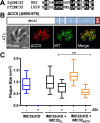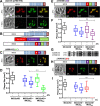Identification and Molecular Dissection of IMC32, a Conserved Toxoplasma Inner Membrane Complex Protein That Is Essential for Parasite Replication
- PMID: 33593973
- PMCID: PMC8545131
- DOI: 10.1128/mBio.03622-20
Identification and Molecular Dissection of IMC32, a Conserved Toxoplasma Inner Membrane Complex Protein That Is Essential for Parasite Replication
Abstract
The inner membrane complex (IMC) is a unique organelle of apicomplexan parasites that plays critical roles in parasite motility, host cell invasion, and replication. Despite the common functions of the organelle, relatively few IMC proteins are conserved across the phylum and the precise roles of many IMC components remain to be characterized. Here, we identify a novel component of the Toxoplasma gondii IMC (IMC32) that localizes to the body portion of the IMC and is recruited to developing daughter buds early during endodyogeny. IMC32 is essential for parasite survival, as its conditional depletion results in a complete collapse of the IMC that is lethal to the parasite. We demonstrate that localization of IMC32 is dependent on both an N-terminal palmitoylation site and a series of C-terminal coiled-coil domains. Using deletion analyses and functional complementation, we show that two conserved regions within the C-terminal coiled-coil domains play critical roles in protein function during replication. Together, this work reveals an essential component of parasite replication that provides a novel target for therapeutic intervention of T. gondii and related apicomplexan parasites.IMPORTANCE The IMC is an important organelle that apicomplexan parasites use to maintain their intracellular lifestyle. While many IMC proteins have been identified, only a few central players that are essential for internal budding have been described and even fewer are conserved across the phylum. Here, we identify IMC32, a novel component of the Toxoplasma gondii IMC that localizes to very early daughter buds, indicating a role in the early stages of parasite replication. We then demonstrate that IMC32 is essential for parasite survival and pinpoint conserved regions within the protein that are important for membrane association and daughter cell formation. As IMC32 is unique to these parasites and not present in their mammalian hosts, it serves as a new target for the development of drugs that exclusively affect these important intracellular pathogens.
Keywords: Toxoplasma gondii; coiled-coil domain; endodyogeny; inner membrane complex; palmitoylation; parasitology.
Copyright © 2021 Torres et al.
Figures







Similar articles
-
IMC29 Plays an Important Role in Toxoplasma Endodyogeny and Reveals New Components of the Daughter-Enriched IMC Proteome.mBio. 2023 Feb 28;14(1):e0304222. doi: 10.1128/mbio.03042-22. Epub 2023 Jan 9. mBio. 2023. PMID: 36622147 Free PMC article.
-
BCC0 collaborates with IMC32 and IMC43 to form the Toxoplasma gondii essential daughter bud assembly complex.PLoS Pathog. 2024 Jul 18;20(7):e1012411. doi: 10.1371/journal.ppat.1012411. eCollection 2024 Jul. PLoS Pathog. 2024. PMID: 39024411 Free PMC article.
-
Identification of IMC43, a novel IMC protein that collaborates with IMC32 to form an essential daughter bud assembly complex in Toxoplasma gondii.PLoS Pathog. 2023 Oct 2;19(10):e1011707. doi: 10.1371/journal.ppat.1011707. eCollection 2023 Oct. PLoS Pathog. 2023. PMID: 37782662 Free PMC article.
-
Organelle Dynamics in Apicomplexan Parasites.mBio. 2021 Aug 31;12(4):e0140921. doi: 10.1128/mBio.01409-21. Epub 2021 Aug 24. mBio. 2021. PMID: 34425697 Free PMC article. Review.
-
Host cell proteins modulated upon Toxoplasma infection identified using proteomic approaches: a molecular rationale.Parasitol Res. 2022 Jul;121(7):1853-1865. doi: 10.1007/s00436-022-07541-4. Epub 2022 May 13. Parasitol Res. 2022. PMID: 35552534 Review.
Cited by
-
Proteomic characterization of the Toxoplasma gondii cytokinesis machinery portrays an expanded hierarchy of its assembly and function.Nat Commun. 2022 Aug 8;13(1):4644. doi: 10.1038/s41467-022-32151-0. Nat Commun. 2022. PMID: 35941170 Free PMC article.
-
Co-dependent formation of the Toxoplasma gondii sub-pellicular microtubules and inner membrane skeleton.bioRxiv [Preprint]. 2024 May 25:2024.05.25.595886. doi: 10.1101/2024.05.25.595886. bioRxiv. 2024. Update in: mBio. 2025 Aug 13:e0138925. doi: 10.1128/mbio.01389-25. PMID: 38826480 Free PMC article. Updated. Preprint.
-
Microbial Pathogenesis in the Era of Spatial Omics.Infect Immun. 2023 Jul 18;91(7):e0044222. doi: 10.1128/iai.00442-22. Epub 2023 May 31. Infect Immun. 2023. PMID: 37255461 Free PMC article. Review.
-
The Kelch13 compartment contains highly divergent vesicle trafficking proteins in malaria parasites.PLoS Pathog. 2023 Dec 1;19(12):e1011814. doi: 10.1371/journal.ppat.1011814. eCollection 2023 Dec. PLoS Pathog. 2023. PMID: 38039338 Free PMC article.
-
The protein phosphatase PPKL is a key regulator of daughter parasite development in Toxoplasma gondii.bioRxiv [Preprint]. 2023 Jun 13:2023.06.13.544803. doi: 10.1101/2023.06.13.544803. bioRxiv. 2023. Update in: mBio. 2023 Dec 19;14(6):e0225423. doi: 10.1128/mbio.02254-23. PMID: 37398039 Free PMC article. Updated. Preprint.
References
Publication types
MeSH terms
Substances
Grants and funding
LinkOut - more resources
Full Text Sources
Other Literature Sources
Research Materials
